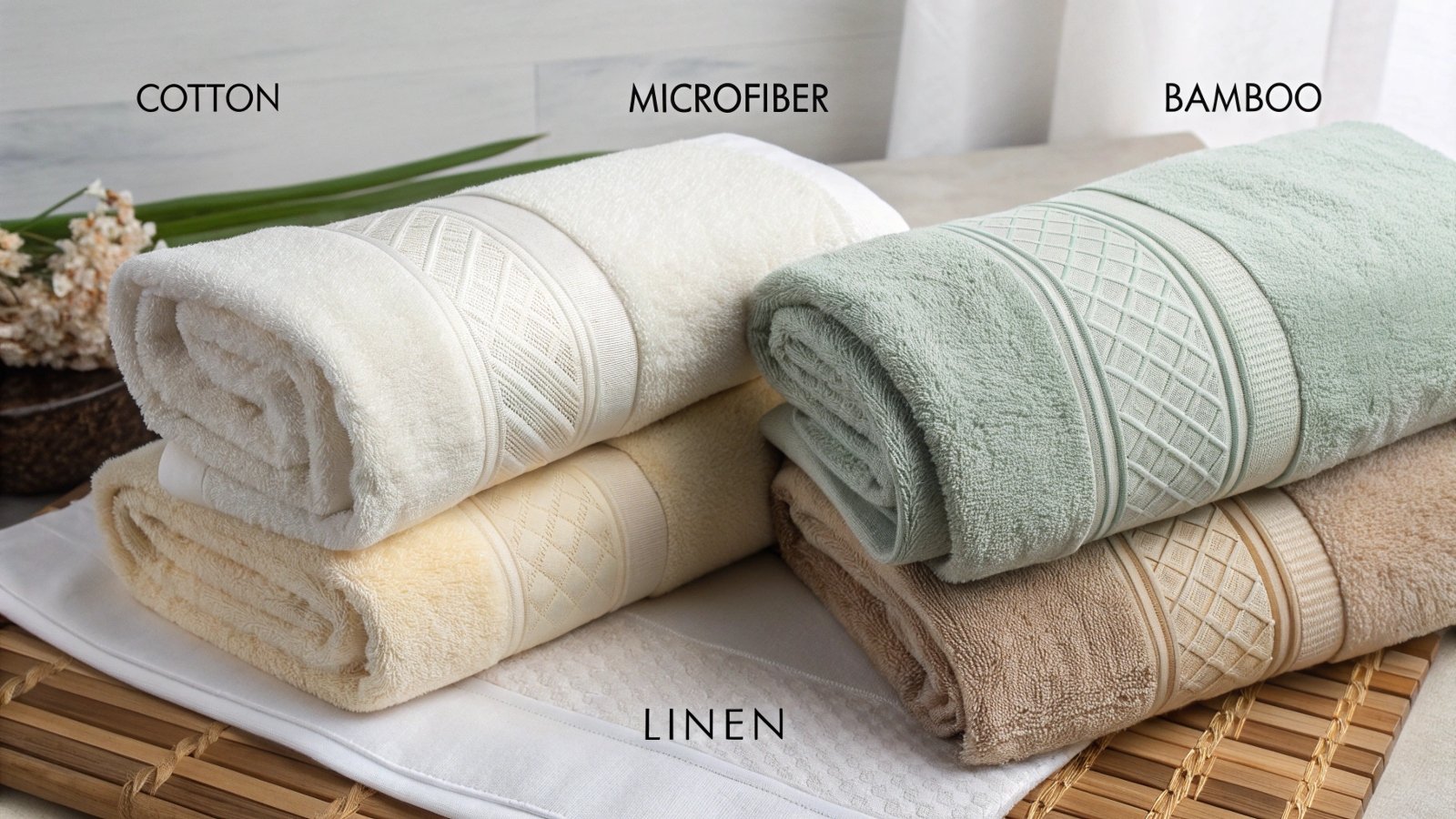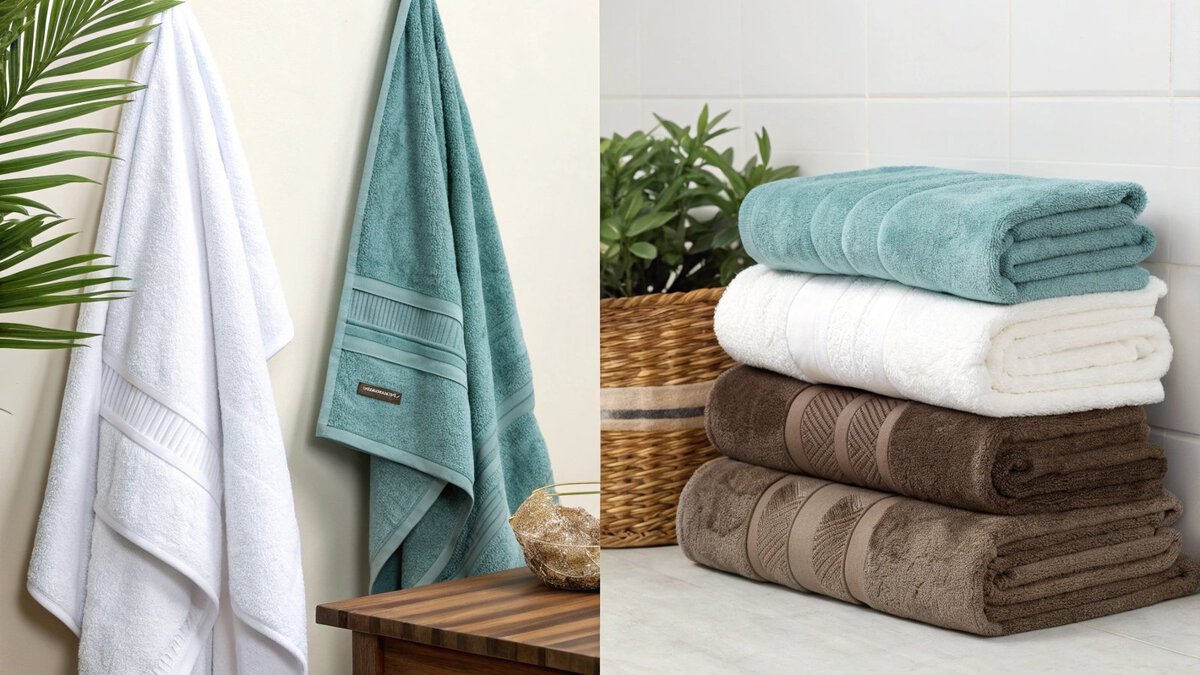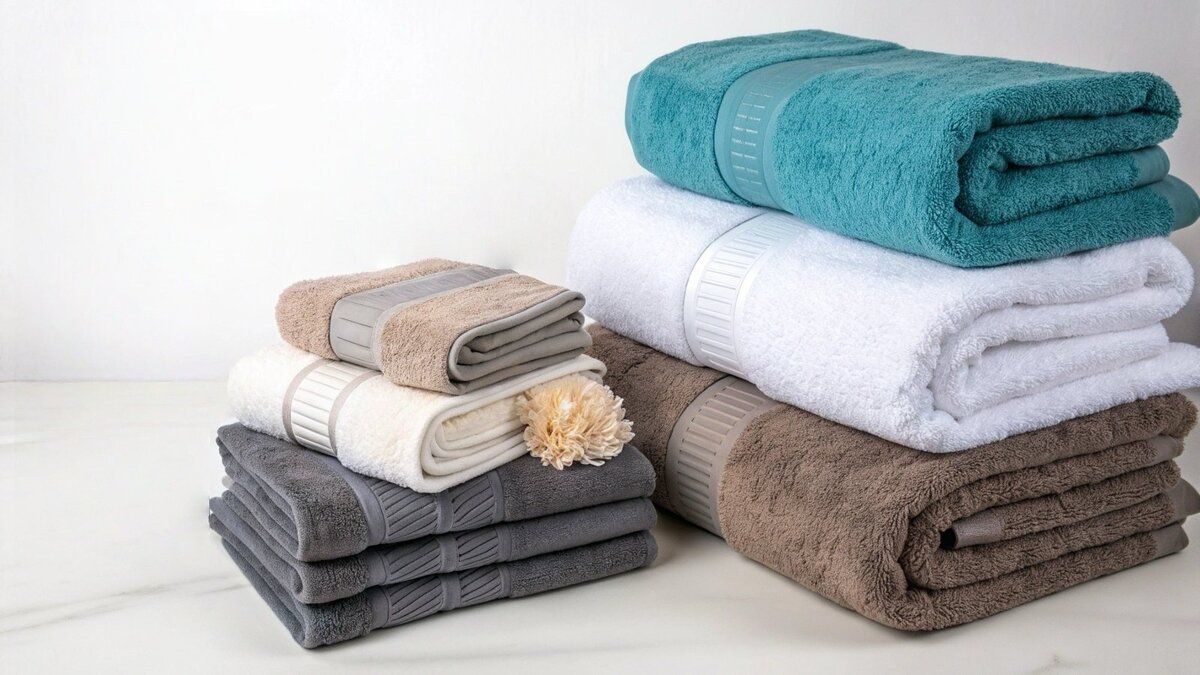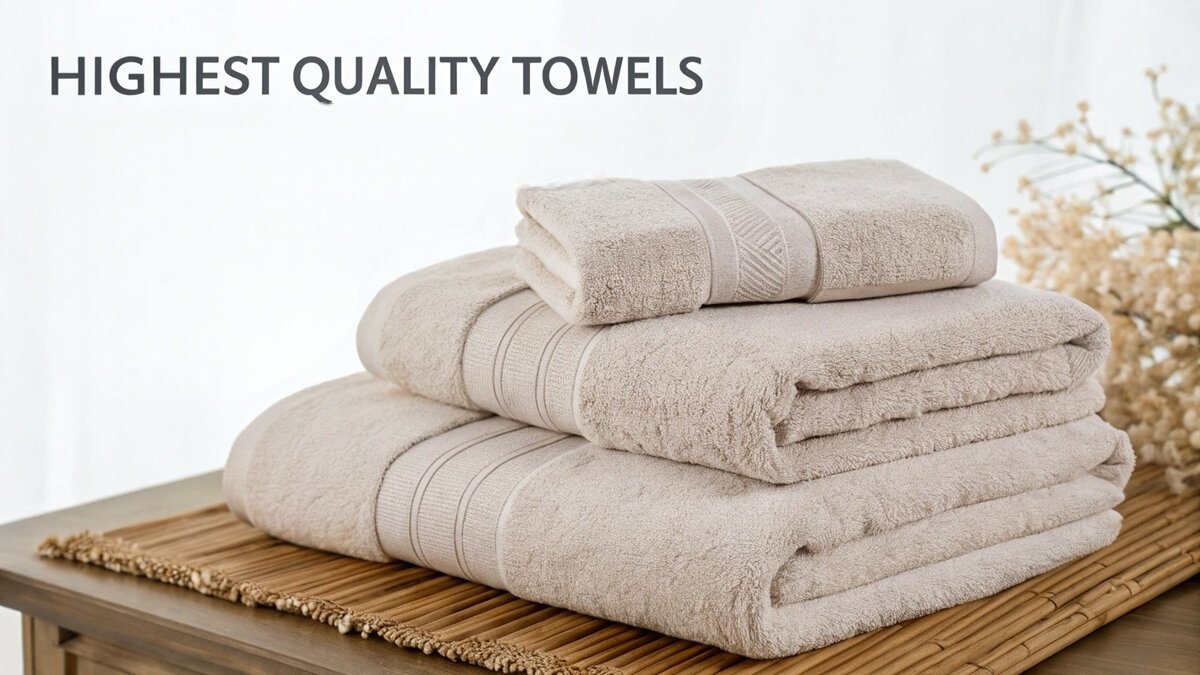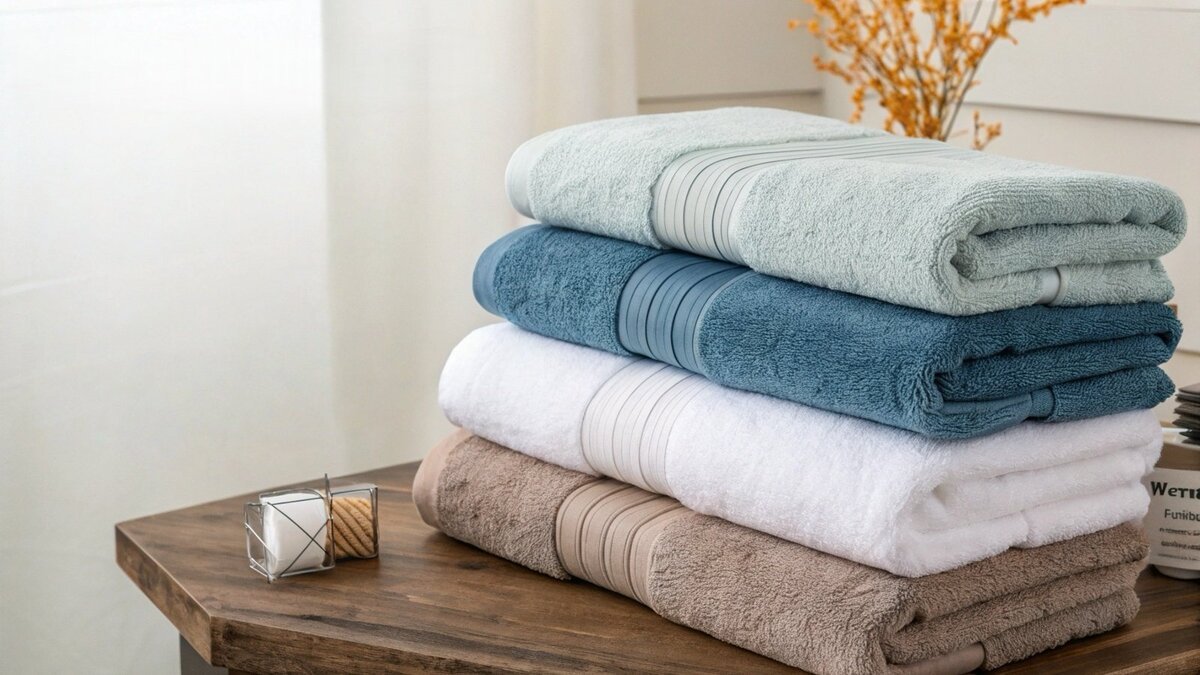Struggling to choose the right towel material for your brand? Making the wrong choice leads to unhappy customers and unsold inventory. Understand your options to ensure a successful, profitable launch.
The most common towel materials are cotton, microfiber, bamboo, and linen. Cotton, especially long-staple varieties like Egyptian or Pima, is prized for luxury and absorbency. Microfiber is excellent for quick-drying and cleaning. Bamboo offers sustainable softness, while linen is known for its durability and unique texture.
But just knowing the names isn’t enough. Each material has specific strengths and weaknesses that directly impact performance, customer satisfaction, and your bottom line. To make a confident decision, you need to understand which material aligns with your brand’s promise and your customer’s needs. Let’s dive deeper and find the perfect fit for your business.
What is the best type of material for towels?
You hear "100% cotton" is best, but the quality varies wildly. This confusion can cause you to overpay for average towels or pick a material that simply doesn’t fit your market.
There is no single "best" material; it depends on the towel’s purpose. For luxury spas, long-staple cottons like Egyptian or Pima are unmatched in softness and absorbency. For gyms or travel, quick-drying microfiber is the superior choice. The "best" material is the one your customer needs.
Choosing the "best" material is about matching fiber properties to your customer’s expectations. I once worked with a client launching a new sports towel line. They were set on Egyptian cotton because of its high-end reputation. We had to explain that while luxurious, it’s heavy and slow to dry—terrible for a gym bag. We guided them to a high-quality, lightweight microfiber instead. The switch prevented a costly mismatch and led to a very successful product launch. The key is to define the primary use first.
Key Towel Material Properties
| Material | Primary Benefit | Best For | Key Consideration |
|---|---|---|---|
| Egyptian/Pima Cotton | Ultimate Softness & Absorbency | Luxury bath, Spa, High-End Hotels | Higher cost, slower to dry |
| Turkish Cotton | Durable & Quick-Drying | Everyday bath, Guest towels | Becomes softer with washes |
| Microfiber | Ultra Quick-Dry & Lightweight | Gym, Travel, Cleaning, Hair | Can feel less "natural" than cotton |
| Bamboo | Sustainable & Hypoallergenic | Baby towels, Sensitive skin | Often blended with cotton |
What are the different types of towels?
You know the materials, but what about the towel types? Ordering a bath towel when your customers expect a lavish bath sheet can lead to disappointment and unsold stock.
Towels are mainly categorized by their size and use. Key types include the small washcloth, the hand towel for drying hands, the standard bath towel for drying the body, and the oversized bath sheet for a luxury, full-coverage experience. There are also specialized towels like beach and gym towels.
Understanding standard dimensions is critical when building a cohesive product line. For our clients, this is a frequent topic of conversation, especially when they are starting out with a low MOQ of 500 pieces to test the market. You don’t want to get stuck with inventory of a size that nobody wants. For example, a brand targeting families might focus on durable, standard-sized bath towels, while a brand targeting luxury condos would do well to include plush bath sheets. It’s all about knowing your audience.
Common Towel Types and Their Uses
| Towel Type | Typical Dimensions (Inches) | Primary Use | Business Insight |
|---|---|---|---|
| Washcloth | 12" x 12" to 13" x 13" | Washing face and body | Great as an add-on item or in gift sets. |
| Hand Towel | 16" x 28" to 18" x 30" | Drying hands in bathrooms | A core item for any home or hotel collection. |
| Bath Towel | 27" x 52" to 30" x 58" | All-purpose body drying after a shower | The most common and essential towel type. |
| Bath Sheet | 35" x 60" to 40" x 70" | Luxury, full-body wrapping | A premium offering that signals luxury. |
| Beach Towel | 30" x 60" to 40" x 70" | Lounging on sand or by the pool | Often thinner, brightly colored, or printed. |
What are the highest quality towels?
"High quality" gets thrown around a lot, but what does it actually mean? Without clear standards, you risk sourcing towels that feel cheap, don’t last, and damage your brand’s reputation.
The highest quality towels are made from long-staple cottons like Egyptian or Supima, with a high Grams per Square Meter (GSM) of 600+. Quality is also found in the details: combed cotton for smoothness, ring-spun yarns for strength, and double-stitched hems for durability.
Quality isn’t a single feature; it’s a combination of the right material, weight, and construction. We once inspected a batch for a client that seemed perfect on paper—high GSM, Turkish cotton. But our in-house QC team found the supplier used cheaper, weaker open-end yarns. We knew they wouldn’t survive the repeated washings required by our client, a hotel chain. We rejected the batch. It’s these invisible details that define true quality and protect your investment. Certifications like OEKO-TEX Standard 100 are also a vital sign, confirming the towel is free from harmful substances.
Indicators of Towel Quality
- Material Fiber: Long-staple cottons (Egyptian, Pima/Supima) produce smoother, stronger, and more absorbent yarns.
- Towel Weight (GSM): GSM stands for Grams per Square Meter. It indicates the towel’s density and plushness.
- 300-400 GSM: Lightweight and thin. Good for the gym or kitchen.
- 400-600 GSM: Medium weight. The perfect everyday bath towel.
- 600-900 GSM: Heavyweight and luxurious. Premium and ultra-absorbent.
- Construction: Look for "combed" cotton (impurities removed), "ring-spun" yarns (smoother and stronger), and double-stitched hems that prevent fraying.
What kind of towels last the longest?
You need towels that can stand up to constant washing without falling apart. Towels that fray, thin out, or lose their absorbency lead to unhappy customers and costly reorders for your business.
For maximum durability, choose towels made from strong, long-staple cotton like Turkish or Pima. The most durable towels use two-ply or ring-spun yarns and have double-stitched hems to prevent unraveling. A mid-range GSM of 500-700 often provides the best balance of longevity and drying speed.
Longevity is built right into the towel’s structure. It starts with the fiber itself. Long-staple cotton fibers, like those from Turkish cotton, are inherently stronger and less prone to breaking. The next factor is how those fibers are spun into yarn. Two-ply yarns, where two strands are twisted together, are significantly more durable than single-ply yarns. For our clients in the hospitality and fitness industries, longevity is a top priority. A towel that lasts 20% longer has a massive impact on their operating budget. That’s why our quality control focuses heavily on these construction markers, ensuring our clients get the best long-term value, even with our flexible 500-piece starting orders.
What to Look For in a Durable Towel
| Feature | Why It Matters for Longevity |
|---|---|
| Long-Staple Cotton | The long fibers are stronger and less likely to pill or break down over time. |
| Two-Ply Yarns | Twisting two yarns together creates a much stronger, denser, and more durable final thread. |
| Ring-Spun Yarns | This spinning process creates a smoother, finer, and more resilient yarn compared to open-end yarns. |
| Double-Stitched Hems | Reinforcing the edges of the towel is the best defense against fraying and unraveling after many washes. |
Conclusion
Ultimately, choosing the right towel material depends on a clear understanding of your brand, your customer, and how the towel will be used. Focus on that, and you’ll make a great choice.

